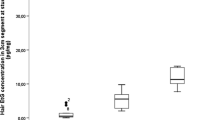Abstract
A drinking experiment with participants suffering from Gilbert’s syndrome was performed to study the possible influence of this glucuronidation disorder on the formation of ethyl glucuronide (EtG). Gilbert’s syndrome is a rather common and, in most cases, asymptomatic congenital metabolic aberration with a prevalence of about 5 %. It is characterized by a reduction of the enzyme activity of the uridine diphosphate glucuronosyltransferase (UGT) isoform 1A1 up to 80 %. One of the glucuronidation products is EtG, which is formed in the organism following exposure to ethanol. EtG is used as a short-term marker for ethyl alcohol consumption to prove abstinence in various settings. After 2 days of abstinence from ethanol and giving a void urine sample, 30 study participants drank 0.1 L of sparkling wine (9 g ethanol). 3, 6, 12, and 24 h after drinking, urine samples were collected. 3 hours after drinking, an additional blood sample was taken, in which liver enzyme activities, ethanol, hematological parameters, and bilirubin were measured. EtG and ethyl sulfate (EtS), another short-term marker of ethanol consumption, were determined in the urine samples using liquid chromatography-tandem mass spectrometry (LC-MS/MS); creatinine was measured photometrically. In all participants, EtG and EtS were detected in concentrations showing a wide range (EtG: 3 h sample 0.5–18.43 mg/L and 6 h sample 0.67–13.8 mg/L; EtS: 3 h sample 0.87–6.87 mg/L and 6 h sample 0.29–4.48 mg/L). No evidence of impaired EtG formation was found. Thus, EtG seems to be a suitable marker for ethanol consumption even in individuals with Gilbert’s syndrome.


Similar content being viewed by others
References
Schmitt G, Aderjan R, Keller T, Wu M (1995) Ethyl glucuronide: an unusual ethanol metabolite in humans. Synthesis, analytical data, and determination in serum and urine. J Anal Toxicol 19:91–94
Dahl H, Stephanson N, Beck O, Helander A (2002) Comparison of urinary excretion characteristics of ethanol and ethyl glucuronide. J Anal Toxicol 26:201–204
Høiseth G, Bernard JP, Karinen R, Johnsen L, Helander A, Christophersen AS, Mørland J (2007) A pharmacokinetic study of ethyl glucuronide in blood and urine: applications to forensic toxicology. Forensic Sci Int 172:119–124
Droenner P, Schmitt G, Aderjan R, Zimmer H (2002) A kinetic model describing the pharmacokinetics of ethyl glucuronide in humans. Forensic Sci Int 126:24–29
Halter CC, Dresen S, Auwärter V, Wurst FM, Weinmann W (2008) Kinetics in serum and urinary excretion of ethyl sulfate and ethyl glucuronide after medium dose ethanol intake. Int J Legal Med 122:123–128
Høiseth G, Karinen R, Johnsen L, Normann PT, Christophersen AS, Mørland J (2008) Disappearance of ethyl glucuronide during heavy putrefaction. Forensic Sci Int 176:147–151
Helander A, Dahl H (2005) Urinary tract infection: a risk factor for false-negative urinary ethyl glucuronide but not ethyl sulphate in the detection of recent alcohol consumption. Clin Chem 51:1728–1730
Helander A, Olsson I, Dahl H (2007) Postcollection synthesis of ethyl glucuronide by bacteria in urine may cause false identification of alcohol consumption. Clin Chem 53:1855–1857
Rohrig TP, Huber C, Goodson L, Ross W (2006) Detection of ethylglucuronide in urine following the application of Germ-X. J Anal Toxicol 30:703–704
Rosano TG, Lin J (2008) Ethyl glucuronide excretion in humans following oral administration of and dermal exposure to ethanol. J Anal Toxicol 32:594–600
Wurst FM, Skipper GE, Weinmann W (2003) Ethyl glucuronide—the direct ethanol metabolite on the threshold from science to routine use. Addiction 98(Suppl 2):51–61
Seidl S, Wurst FM, Alt A (2001) Ethyl glucuronide—a biomarker for recent alcohol consumption. Addict Biol 6:205–212
Wurst FM, Kempter C, Metzger J, Seidl S, Alt A (2000) Ethyl glucuronide: a marker of recent alcohol consumption with clinical and forensic implications. Alcohol 20:111–116
Substance Abuse and Mental Health Services Administration (2012) The role of biomarkers in the treatment of alcohol use disorders, 2012 revision, Volume 11, Issue 2 (www.samhsa.gov, 23.05.2014)
Fretzayas A, Moustaki M, Lipai O, Karpathios T (2012) Gilbert syndrome. Eur J Pediatr 171:11–15
Gil J, Sasiadek MM (2012) Gilbert syndrome: the UGT1A1*28 promoter polymorphism as a biomarker of multifactorial diseases and drug metabolism. Biomark Med 6:223–230
Gerok W (2000) Krankheiten der Leber und des biliären systems. In: Gerok W, Huber C, Meinertz T, Zeidler H (eds) Die Innere Medizin, 10th edn. Schattauer, Stuttgart, New York, 673
Maralikova B, Schaefer P, Thierauf A, Stumptner D, Wurst FM, Weinmann W (2003) Determination of ethyl glucuronide in urine after drinking small amounts (9 g) of ethanol. In: Pragst F, Aderjan R (Hrsg) Ausgewählte Aspekte der Forensischen Toxikologie, Tagungsband zum XIII. GTFCh-Symposium, 03–05. April 2003 in Mosbach, Verlag Dr. Dieter Helm, Heppenheim, S. 379–382
Schloegl H, Dresen S, Spaczynski K, Stoertzel M, Wurst FM, Weinmann W (2006) Stability of ethyl glucuronide in urine, post-mortem tissue and blood samples. Int J Leg Med 120:83–88
Peters FT, Hartung M, Herbold M, Schmitt G, Daldrup T, Mußhoff F (2009) Anhang B zu den Richtlinien der GTFCh zur Qualitätssicherung bei forensisch-toxikologischen Untersuchungen; Anforderungen an die Validierung von Analysenmethoden. Toxichem Krimtech 76:185–208
Foti RS, Fisher MB (2005) Assessment of UDP-glucuronosyltransferase catalyzed formation of ethyl glucuronide in human liver microsomes and recombinant UGTs. Forensic Sci Int 153:109–116
Schwab N, Skopp G (2014) Identification and preliminary characterization of UDP-glucuronosyltransferases catalyzing formation of ethyl glucuronide. Anal Bioanal Chem 406:2325–2332
Acknowledgments
The authors would like to thank the Bund gegen Alkohol und Drogen im Straßenverkehr B.A.D.S. for the financial support of the drinking experiment.
Conflicts of interest
There are no conflicts of interest to declare.
Author information
Authors and Affiliations
Corresponding author
Additional information
Dedicated to Prof. Dr. Stefan Pollak on the occasion of his 65th birthday
Laura M. Huppertz and Leonie Gunsilius contributed equally to this manuscript.
Rights and permissions
About this article
Cite this article
Huppertz, L.M., Gunsilius, L., Lardi, C. et al. Influence of Gilbert’s syndrome on the formation of ethyl glucuronide. Int J Legal Med 129, 1005–1010 (2015). https://doi.org/10.1007/s00414-015-1157-7
Received:
Accepted:
Published:
Issue Date:
DOI: https://doi.org/10.1007/s00414-015-1157-7




